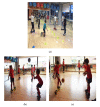Effects of Hoverboard on Balance in Young Soccer Athletes
- PMID: 33467275
- PMCID: PMC7739259
- DOI: 10.3390/jfmk5030060
Effects of Hoverboard on Balance in Young Soccer Athletes
Abstract
Hoverboards are always more popular among children. Hoverboards are to them like a game or a mean of transport, but they could be used as a valid and useful instrument in children's training programs to improve their performance. In this study, we compared the athletic performance of two groups of 12 children. A total of 24 children aged between 8 and 11 years followed a similar training program for five months, but the first group used a hoverboard (Hb+ group: Age: Standard Deviation (SD) = 1.15 Mean = 9.66; Weight: SD = 5.90 Mean = 32; Height: SD = 7.64 Mean = 135.08) for some of the training time, differently from the second group (Hb- group: Age: SD = 1.15 Mean = 9.66; Weight: SD = 5.82 Mean = 31.16; Height: SD = 7.66 Mean = 136.16), which never used it. All of the children were asked to complete three tests (one leg test, stork test and balance beam walking test) before starting their own training program and after five months, to evaluate how their performances changed in terms of time. Comparing the recorded time difference between T0 and T1 of the Hb+ group with the same difference measured in Hb- group, it was found that there was a statistically significant difference (p value < 0.05) between these data for all three tests. Children who used the hoverboard in their training program achieved better result than children who did not use it. In the future, the hoverboard could help athletes to improve their performances, possibly applying it not only in football training, but even in other sports.
Keywords: balance; children; hoverboard; proprioception.
Conflict of interest statement
The authors declare no conflict of interest.
Figures





Similar articles
-
Effects of Plyometric Training on Components of Physical Fitness in Prepuberal Male Soccer Athletes: The Role of Surface Instability.J Strength Cond Res. 2017 Dec;31(12):3295-3304. doi: 10.1519/JSC.0000000000002262. J Strength Cond Res. 2017. PMID: 29023331 Clinical Trial.
-
Integrated injury prevention program improves balance and vertical jump height in children.J Strength Cond Res. 2010 Feb;24(2):332-42. doi: 10.1519/JSC.0b013e3181cc2225. J Strength Cond Res. 2010. PMID: 20072067 Clinical Trial.
-
Hoverboards: A new cause of pediatric morbidity.Injury. 2017 Jun;48(6):1110-1114. doi: 10.1016/j.injury.2017.03.028. Epub 2017 Mar 27. Injury. 2017. PMID: 28372790
-
Frequency and Magnitude of Game-Related Head Impacts in Male Contact Sports Athletes: A Systematic Review and Meta-Analysis.Sports Med. 2019 Oct;49(10):1575-1583. doi: 10.1007/s40279-019-01135-4. Sports Med. 2019. PMID: 31175636
-
Match Running Performance in Young Soccer Players: A Systematic Review.Sports Med. 2019 Feb;49(2):289-318. doi: 10.1007/s40279-018-01048-8. Sports Med. 2019. PMID: 30671900
Cited by
-
Hallux Limitus: Exploring the Variability in Lower Limb Symmetry and Its Connection to Gait Parameters-A Case-Control Study.Bioengineering (Basel). 2025 Mar 14;12(3):298. doi: 10.3390/bioengineering12030298. Bioengineering (Basel). 2025. PMID: 40150761 Free PMC article.
-
Variability of Postural Stability and Plantar Pressure Parameters in Healthy Subjects Evaluated by a Novel Pressure Plate.Int J Environ Res Public Health. 2022 Mar 2;19(5):2913. doi: 10.3390/ijerph19052913. Int J Environ Res Public Health. 2022. PMID: 35270606 Free PMC article.
-
Indirect Structural Muscle Injuries of Lower Limb: Rehabilitation and Therapeutic Exercise.J Funct Morphol Kinesiol. 2021 Sep 13;6(3):75. doi: 10.3390/jfmk6030075. J Funct Morphol Kinesiol. 2021. PMID: 34564194 Free PMC article. Review.
-
Evaluations of Muscular Strength, Ability to Balance and Health Status in Prisoners during COVID-19.Int J Environ Res Public Health. 2021 Apr 19;18(8):4316. doi: 10.3390/ijerph18084316. Int J Environ Res Public Health. 2021. PMID: 33921737 Free PMC article.
-
Postural stability and plantar pressure parameters in healthy subjects: variability, correlation analysis and differences under open and closed eye conditions.Front Bioeng Biotechnol. 2023 Jul 20;11:1198120. doi: 10.3389/fbioe.2023.1198120. eCollection 2023. Front Bioeng Biotechnol. 2023. PMID: 37545891 Free PMC article.
References
-
- Francesconi K., Gandini G. L’intelligenza Nel Movimento. Percezione, Propriocezione, Controllo Posturale. Edi-Hermes; Milano, Italia: 2015. p. 53.
-
- Lloyd R.S., Oliver J.L. The youth physical development model: A new approach to long-term athletic development. J. Strength. Cond. 2012;34:61–72. doi: 10.1519/SSC.0b013e31825760ea. - DOI
-
- Oliver J.L., Lloyd R.S., Meyers R.W. Training elite child athletes: Welfare and well-being. J. Strength. Cond. 2011;33:73–79. doi: 10.1519/SSC.0b013e318216a9b6. - DOI
-
- von Hofsten C., Rosander K. The Development of Sensorimotor Intelligence in Infants. Adv. Child. Dev. Behav. 2018;55:73–106. - PubMed
LinkOut - more resources
Full Text Sources

